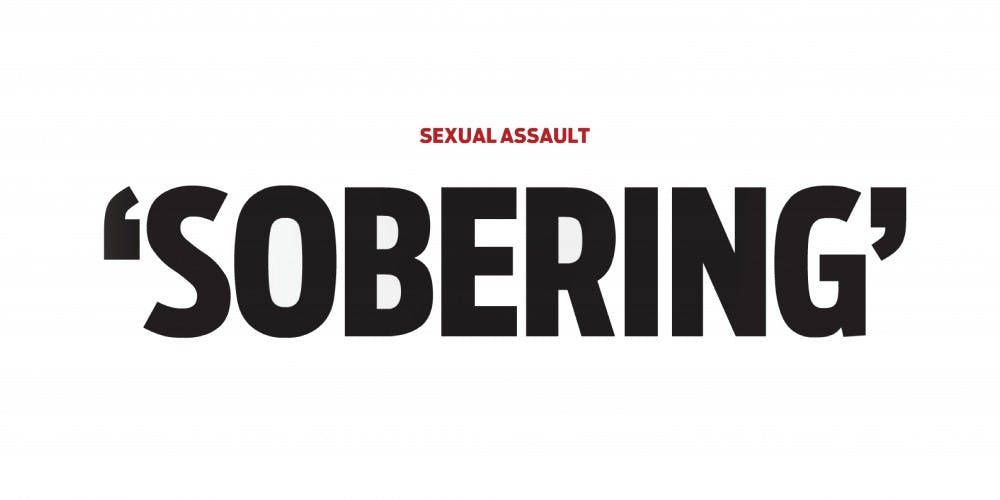“But it’s also a cultural problem,” she said. Fasone is the lead administrator on the IU-Bloomington’s Community Attitudes and Experiences with Sexual Assault survey.
Of the women who experienced sexual assault at IU by the end of the fall semester last year, 86 percent did not report the incident, according to data from IU’s first sexual assault climate survey, which was released Tuesday.
“Unless somebody reports it, our hands are tied,” said Fasone, assistant dean for women’s and gender affairs. Among the undergraduate women who chose not to report sexual misconduct, 45 percent said they also felt it was not “serious enough to disclose to others.”
They didn’t tell anyone.
Data from the report sheds light on what is needed from IU: increased risk and prevention efforts. But until attitudes, beliefs and perceptions change, the administration’s role will only have so much bearing, Fasone said.
“Students are invaluable to creating change,” Fasone said.
* * *
The 162-question online sexual assault survey first reached students’ emails in early November of last year.
Six days later, students received the survey for a second time from Dean of Students Harold “Pete” Goldsmith. His subject line read, “It’s On Us: A serious issue that affects us all.” He wrote, “We need everyone’s response. It all starts with you.”
A third and final email came from Goldsmith on Nov. 30, 2014, three days before the deadline for responses, with the subject line: “FINAL MESSAGE — A serious issue that affects us all.”
Almost a year later, a total of 7,132 student responses were compiled into the administration’s final report, released Tuesday.
This is the first sexual assault survey of its kind IU has conducted. It is a result of increased scrutiny of how universities’ administrations address sexual assault.
On May 1, 2014, news broke that IU-Bloomington was under Title IX compliance review, meaning the United States Department of Education would look into the mishandling of campus sexual assault cases.
An exact breakdown of the survey’s funding could not be provided by Fasone Tuesday. About $5,000 of a grant through the Women’s Philanthropy Council helped pay for data cleaning, while the Provost’s Office provided money for the 400 $50 Amazon gift cards, which were used to incentivise response.
Fasone began working on a survey for IU before the compliance review began. She and Justin Garcia, a researcher at the Kinsey Institute, aimed to mirror the White House’s “Not Alone” survey, released in April of 2014, while drawing on other key components of analysis.
Community Attitudes and Experiences with Sexual Assault full report
* * *
The survey is broken down into three sections: campus culture, experiences of sexual misconduct and attitudes, perceptions and beliefs. If respondents reported that they had experienced misconduct, they were given the option to elaborate.
About 36 percent of female students — 431 individuals — who reported nonconsensual sexual activity went on to give more information about what had happened.
The section on campus culture helps Fasone better understand the feelings students have toward the University, which she said will be helpful especially in prevention efforts.
Questions about how drunkenness plays into consent were added to this section because it is an issue students bring up often, Fasone said.
“That’s one of our biggest challenges working with some of our students, is to help them better understand alcohol and consent and what ‘impaired’ means,” she said.
Among undergraduates, about 20 percent of men and 12 percent of women surveyed agreed that, “A woman who is drinking heavily can still give legal consent to sexual assault activity.”
Additionally, alcohol or drug use or some combination thereof was present in as many as 83 percent of incidents reported.
* * *
Fasone said people who have experienced sexual assault may have been less likely to take the survey or continue answering questions about their experiences with nonconsensual sexual contact.
All in all, the sample size was large enough and comprehensive enough to construct an authentic picture of sexual assault experiences and attitudes at IU.
The sexual misconduct experiences section has provided information that, until now, IU could only estimate.
The information is important because sexual assault is so underreported, she said.
“To learn about that and say, ‘Here’s what’s actually happening,’ is incredibly important,” Fasone said. “It’s sobering.”
* * *
This Saturday a conference, open to college students across Indiana, will take place at IU-Purdue University Indianapolis. Next Tuesday there will be a panel discussion for students to listen and ask questions.
Communication is also a big part of what prevention looks like to the administration. IU is working on framing their messages more consistently across prevention and education platforms.
Fasone said one of the biggest reasons students do not tell anyone about a sexual assault incident is “fear of retaliation.”
Providing information to people about where they can share their stories and where they can get connected to campus resources is a vital part of her job.
While she’s already seen an increase in reporting through the Office of Student Ethics, the number of unreported incidents remains very high. IU plans to continue educating students on the sexual misconduct process, in an effort to hold students accountable.
Fasone said she hopes these efforts, combined with student participation, can eventually change the culture.
This story is part of ongoing reporting by the IDS Investigations staff. Contact investigations@idsnews.com for inquiries or comments.
Read part one of the IDS's previous investigative coverage of sexual assault at IU here, and part two here.






